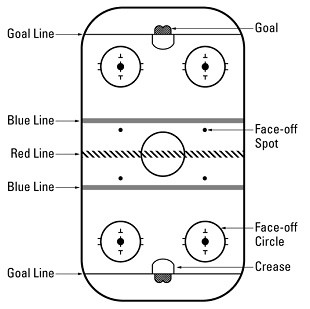OFFSIDES HOCKEY: The offside regulation is one that can confuse most fans and some novice players. So, what is offsides in hockey?
This guide explains the rudiments of the offside position in ice hockey.
Most popular team sports have some rules to regulate forward movement.
The IIHF Ice Hockey Official Rules abolished forward passes in the game since the 1930s.
Even though ice hockey offside rules still remain in the game, the same laws do not exist in field hockey rules.
The introduction of the offside rule in ice hockey redefined the high-speed game. So let us explain how the ice hockey offside position works.
Offside Rule in Ice Hockey
If you have read the rules of ice hockey you will already know the rink has three zones. A blue line delineates each third of the playing surface.
The team defending zone is the end running from the goal to the first blue line. A middle third extends from the first blue line to the second blue line called the neutral zone.
A third section beyond the second blue line will be your team attack zone. The National Hockey League rule book refers to the offside position. It summarizes the spirit of offside in ice hockey regulation.
Offsides in Hockey: Rule 82
 Players of the attacking team must not precede the puck into the attacking zone.
Players of the attacking team must not precede the puck into the attacking zone.
This rule refers to all ice hockey playing positions. No player can have both skates in the attacking zone when the puck crosses over that blue line.
The player would be in an offside position and caught offside. Ice hockey officials and linesmen have the responsibility of enforcing all offside calls.
The penalty for being in an offside position depends on your specific league rules. As a rule the infringement results in one of two ways:
- Delayed Offside: Play may continue until the attacking team touches the puck.
- Immediate Offside: Linesman blows the play dead following an instance of this offside play.
Further explanation: The delayed offside rule means no possession gets stripped from the defending team. It allows them to win possession of the puck while the opposition is offside. The attacking team must completely regroup in the neutral zone to clear the offside call.
The outcome will usually be the same no matter which regulations your league follows. The linesman blows his whistle and play will not continue.
Note: The result is a faceoff played in the neutral zone taken at the faceoff dot nearest to the rules’ infraction.
ALSO IN THIS SECTION
Where Does the Word Offside Come From?
The word ‘offside’ is shortened from British history war sayings. Being “off the strength of his side” meant a soldier was in a trapped position behind enemy lines.
What are 10 Basic Rules of Ice Hockey?
Learn how to play the game with these 10 simple rules of ice hockey for beginners. We start off with the top ten professional playing regulations and match tactics.
What Equipment is Needed for Ice Hockey?
The game is fast and furious most of the time! This ice hockey equipment list explains what you will need as a player or goalie.

